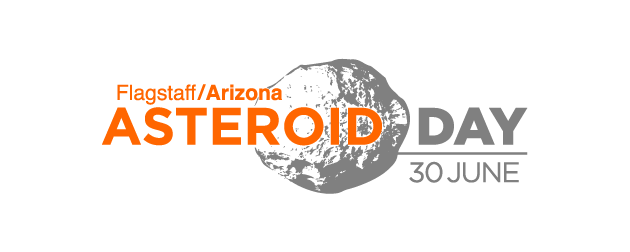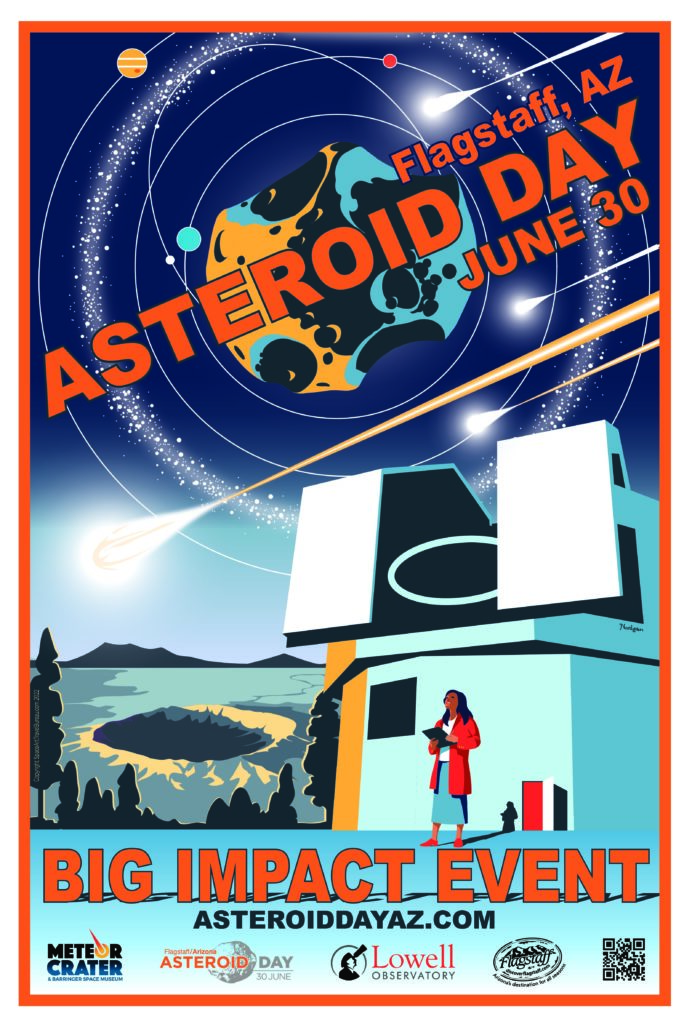
FOR IMMEDIATE RELEASE
JUNE 10, 2022
***Contact details appear below
***Event Website: https://www.asteroiddayaz.com/
Flagstaff, AZ. – Meteor Crater and Lowell Observatory will host a one-day public event centered around asteroids and their impact on Earth. Asteroid Day Flagstaff – Big Impact Event will take place on June 30, with scientific programs, tours of both facilities, food trucks, local beer, science demonstrations, and night-sky telescope viewing.
Flagstaff Mayor Paul Deasy and Coconino County Supervisor Jeronimo Vasquez will be at Lowell Observatory, and Winslow Mayor Roberta “Birdie” Cano will be at Meteor Crater, to proclaim “Asteroid Day” as an officially recognized day in both Flagstaff and Winslow, respectively.
Meteor Crater will host daytime events from 11 a.m. – 5 p.m PDT, and Lowell Observatory will host evening activities from 5 p.m. – 11 p.m. PDT. Programs will address various aspects of asteroids—what they are, how scientists look for them, the nature of impacts on Earth, planetary defense issues, and how Apollo astronauts studied Meteor Crater to prepare for their voyages to the impact-scarred Moon. A full list of programs is available at https://www.asteroiddayaz.com/.
“Lowell Observatory is excited to partner with Meteor Crater to commemorate Flagstaff’s first Asteroid Day,” said Dr. Danielle Adams, Chief Marketing and Revenue Officer at Lowell Observatory. “Given our proximity to the world’s best-preserved meteorite impact site and the heritage of tens of thousands of asteroid discoveries at Lowell over the years, Flagstaff is the world’s best place to mark Asteroid Day.”
The Asteroid Day Flagstaff-Big Impact Event is one of many independently organized activities around the world supported by the United Nations-sanctioned program called Asteroid Day. It is designed to raise public awareness about asteroids and their risks. It was founded in 2014 and features events generally taking place on June 30—the date, in 1908, of the largest recorded asteroid impact on Earth.
Matt Kent, CEO and President of Meteor Crater and the Barringer Space Museum, said, “Right here in northern Arizona, we can see the literal impact of asteroids on our planet. What better place to hold an Asteroid Day event than here?”
For schedule, ticketing, and other information about Asteroid Day Flagstaff-Big Impact Event, see https://www.asteroiddayaz.com/.
###
About Meteor Crater
Meteor Crater is the best-preserved meteor impact crater on Earth! More than 50,000 years ago, space and Earth came together when a huge iron-nickel meteorite, approximately 150 feet wide and weighing several hundred thousand tons, impacted an area outside of Flagstaff, Arizona, with a force 150 times greater than an atomic bomb! The result of this impact was devastation for miles and the creation of the giant bowl-shaped cavity we call Meteor Crater, which measures 550 feet deep and almost a mile wide. The Crater is large enough for 20 football games to be played simultaneously on its floor, while more than two million people could watch from the side slopes. Scientists have carried out research at the site for decades, Apollo astronauts trained there in preparation for their journeys to the Moon in the 1960s-70s, and more than a quarter million tourists visit the site each year.
About Lowell Observatory
Lowell Observatory is a private, nonprofit 501(c)(3) research institution, founded in 1894 by Percival Lowell atop Mars Hill in Flagstaff, Arizona. The Observatory has been the site of many important discoveries, including the first detection of large recessional velocities (redshift) of galaxies by Vesto Slipher in 1912-1914 (a result that led ultimately to the realization that the universe is expanding), and the discovery of Pluto by Clyde Tombaugh in 1930. Today, the Observatory’s 14 tenured astronomers use ground-based telescopes around the world, telescopes in space, and NASA planetary spacecraft to conduct research in diverse areas of astronomy and planetary science. Lowell Observatory currently operates multiple research instruments at its Anderson Mesa station, east of Flagstaff, and the 4.3-meter Lowell Discovery Telescope near Happy Jack, Arizona. Prior to the pandemic, the observatory also welcomed more than 100,000 guests per year to its Mars Hill campus in Flagstaff, Arizona, for a variety of educational experiences, including historical tours, science presentations, and telescope viewing.
###
Media Contacts
Kevin Schindler
Lowell Observatory PIO
(928) 607-1387
Gary Tarr
Free Range Production
(480) 332-9031
gary@outsidethecoop.com